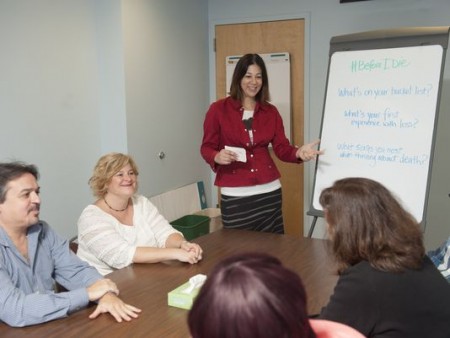By Kim Mulford
Christine Corti knows how hard it can be to talk openly about death and dying. The 39-year-old graphic designer for Samaritan Healthcare & Hospice spends her work day surrounded by the discussion.
Her own mother scolds her when Corti says someone has “died.” Her parents are more conservative than she is, more private, more dignified, she explained.

“They didn’t grow up in the social media world where people are talking about what they ate,” said Corti, who also handles Samaritan’s social media. “You didn’t have intimate conversations about a lot of topics, including being sick and dying.”
But the discussion is more important now than ever.
Last year, Samaritan launched headlong into a project intended to break down those unspoken conversation barriers. It devised a campaign asking people to talk about their end-of-life care, using community events and games as conversation starters.
The work grew out of Samaritan’s own experience, as employees shepherded families making critical medical decisions for their loved ones, explained Joanne Rosen, who leads Samaritan’s initiative.
“Those decisions are heart-wrenching,” Rosen said. “We really believe that the best time to start having those conversations is early on. We suggest while we’re all healthy, not just when somebody is diagnosed.”
The need is clear.
According to a “Health Matters” poll conducted by the New Jersey Health Care Quality Institute and the Monmouth University Polling Institute, more than 54 percent of New Jersey residents have no legal documents expressing their wishes for end-of-life care. Another 38 percent have never talked about advanced care planning.
But people should make that conversation part of their routine health care, even when in their 20s, said Dr. Stephen Goldfine, Samaritan’s medical director.
“If you start having these conversations, it normalizes the conversation,” Goldfine said. Starting in 2016, physicians will be reimbursed for having that conversation with patients, which Goldfine called “a big step forward.”
Often, medical care is provided without knowing what the patients’ desires are, he explained. Decisions are often made when patients aren’t able to make them. That could mean a person’s life is extended through aggressive interventions, such as long periods spent on breathing machines, against their wishes.
“Just because we can do something, should we do it?” Goldfine asked. “For physicians, as we have more and more interventions, it becomes harder for us.”
Everyone needs to define his or her own quality of life, he explained. A self-defined “talker,” Goldfine said if he can no longer have a rational conversation with his loved ones, he doesn’t want aggressive care to extend his life — “I just want to be kept comfortable.”
Getting young people to talk about death isn’t as hard as one might think. That same “Health Matters” poll found 73 percent of respondents said they are comfortable with the idea of aging and death, and start thinking about it as early as age 30.
In some circles, it’s even earlier.
For the past nine years, Samaritan has helped Moorestown Friends School offer a semester-long course on hospice care. And though the class delves into difficult territory, it’s become a popular elective, explained Priscilla Taylor-Williams, a teacher who leads the religion department at the school.
“I think in some ways, it’s kind of a relief to be able to ask the real questions, and share some concerns,” Taylor-Williams said. “I think it helps that all of the adults who talk to them are comfortable. That’s the huge piece right there. … We are not afraid of this conversation.”
And it’s not like teens haven’t encountered death in their own lives. Indeed, the course was launched after the deaths of a teacher and a student. After taking the course, some students have used what they learned in their own families, Taylor-Williams said.
“I know kids talk about it,” Taylor-Williams said. “Most teens I know have lost someone by the time they’re in these high school years, or they’re watching someone go through some pretty serious illness in their families. I think it’s helpful to have a way to talk about it.”
Corti, the Samaritan graphic designer, thinks younger people are more open to a discussion about end-of-life care. She suggests making it a part of casual conversation, when out to dinner or in a car ride.
“Just put little droplets of those thoughts out there,” Corti said. “It just might help open that conversation for the next time.”
